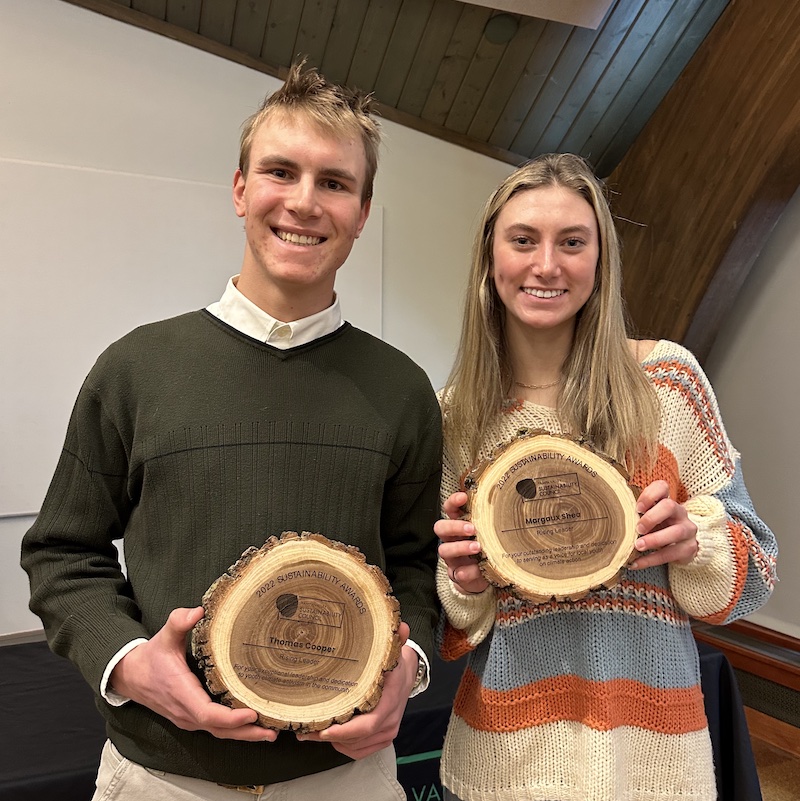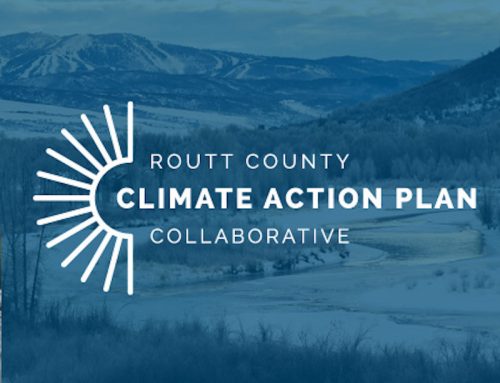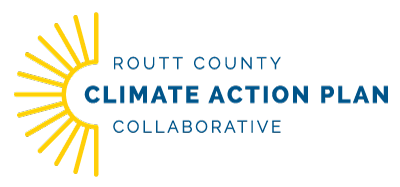Thomas Cooper and Margaux Shea
Thomas Cooper and Margaux Shea are two passionate and committed student environmental activists who have been making a difference in their community through their involvement with the Steamboat Springs High School Eco Club. In a recent article with the Steamboat Pilot, they discussed the urgency of addressing climate change and their efforts to raise awareness and spur action at the local level. Through their inspiring work, Thomas and Margaux are inspiring others to take action and make a positive impact on the planet. Both recently answered our questions about the importance of participating in climate action now, their thoughts on why the CAP is significant and their plans for the future.
Why did you choose to become a member of the Steamboat Springs High School Eco Club and Fridays for the Future?
Thomas: I originally joined the SSHS Eco Club and attended Fridays for Future largely due to my sister, Emi Cooper, who had a leadership role in both of those organizations and encouraged me to join. I agreed – even then I knew the importance of climate action and felt the need to act – but I was apprehensive. I had previously found environmental advocacy to be hard, often discouraging work, and was not yet ready to make it a defining passion of mine. However, as soon as I attended my first meeting, I noticed something special about the Eco Club: where much of the advocacy I had done before was cold and serious, making me feel scared and often hopeless, the Eco Club was a warm place, full of regular kids doing vital work, and having fun doing it. Fridays for Future protests were nothing like I imagined a protest to be. They were full of laughter, signs that made light of the crisis we were facing, mixed with a steadfast determination to change the world. In short, I joined the Eco Club and Fridays for Future because they had hope that we could make a better world, and were proving themselves right through their work. Since then, all of those people have graduated, but I believe Margaux and I have managed to preserve that culture, and have continued to make an impact.
Margaux: I first joined the High School Eco Club and local Fridays for Future chapter as a freshman eager to engage with my community. I never once questioned why I should join the respective organizations because it never occurred to me not to. Growing up in a town where mountains are our playground, I feel most at peace when I am in nature. Climbing, skiing, fishing, and other activities I immerse myself in taught me a deep sense of gratitude for the beautiful place I am fortunate to call home and to fight to protect what surrounds me and preserve it for future generations. This deep-rooted connection to nature led me to initially join the Eco Club to pursue attainable action. I was inspired by the preceding work of my peers, primarily Emi Cooper who served as a mentor and motivator for many years.
It has been mentioned that “climate change is the most important issue of our time,” what do you think are the most pressing issues and the most effective ways to combat them?
Thomas: It is absolutely true that climate change is the most important issue of our time. This is not a political opinion, this is a scientific fact. No other issue poses such a threat to all of humanity, and no other issue requires such urgency to solve. The sheer magnitude of global climate change means it has many complex, cascading, and often devastating effects, such as wildfires, lost biodiversity, humanitarian disasters caused by extreme weather, and many more. Each of these issues is important and needs to be solved. However, they are symptoms of the climate crisis, not the root cause. To truly solve the most important issue of our time, possibly in all of history, we must focus on the root cause, which is greenhouse gas emissions. Luckily, we know exactly how to combat these. We’ve had these solutions for about 20 years. They are switching to low-emission and emission-free sources of electricity. They are natural carbon sequestration. They are reducing wasteful consumption. We know how to solve climate change, and all we need to do is implement these solutions.
Margaux: As climate conversations have become increasingly more prevalent in the political, scientific, and social settings, the necessity for change has not been equally matched. The effects are not exclusive to coastal cities, we face them in our own secluded valley. Climate change threatens every individual on this planet, and it will take all of us to take effective action. Greenhouse gas emissions are the most outstanding contributor to climate change in the form of fossil fuels – coal, oil, and gas – and are responsible for over 75% of global emissions. As technological advances and explorations have developed the use of renewable energy sources, it is vital that countries support their local municipalities in an effective and cohesive switch.
What scares you the most about the future we face without aggressive climate action now?
Thomas: I will be entirely honest, I’ve been asked this question many times, and while I see its value, I don’t like it. Of course I’m scared. I’ve seen the outdoors where I grew up devastated by the climate crisis. Every day, I see headlines of pain and devastation caused by extreme weather disasters. I am 17, and every time I think of my future, my career, or my children, I’m reminded of an important caveat: I might not get it. My fondest memories of my childhood are of my parents teaching me how to ski, and I look forward to teaching my own to ski someday, but if the climate crisis is left unchecked, I will never get that experience. So in short, I am terrified, and you should be too. However, fear is easy, it spreads fast, but it is paralyzing. When we focus solely on how huge of a crisis we are facing, we freeze. Rather than acting, we hide, pretend there is no threat, and refuse to act. I spent many years of my life paralyzed by fear, and because of that, I believe we as climate activists should focus on hope. Hope is powerful, hope is motivating, and hope tells us that we can and will solve this crisis. The climate movement is built off fear, but we can move forward with hope. The threat is real, but we can solve it, and build a better world.
Margaux: As a young environmental advocate, I am not fighting for a future that I will not live to see. Climate change is occurring here and now, I am fighting for the present. Climate change is also a main contributor to the three pillars of sustainability: economy, equity, and environment. The effects of climate change extend beyond the physical consequences observed in nature. If action is not taken, every aspect of our society will suffer. My greatest fear of not battling climate change is not the disasters we will face, but our unwillingness to adapt. We have the scientific support and technology to execute positive action, but are hesitant to implement which will be our greatest downfall.
Why is the Routt County CAP significant? What do you think are the most important components and what input do you have regarding how to achieve success?
Thomas: At its core, the Routt County CAP is a commitment to do better – to act on the climate crisis. By passing the CAP, our leaders made a promise to our community and our children, a promise that they will prioritize the environment and the future. In that capacity alone, it is essential. Beyond that, the CAP has assembled a group of qualified, local experts in the CAP collaborative that are in the process of creating specific science-based recommendations for how to fulfill this commitment. This bringing together of leaders, experts, and community members creates a coordinated response which I believe is the most important component of the CAP. To effectively act on the climate crisis, we need everybody’s input at every step. Secondly, in regard to the specific strategies in the CAP, Land Use Strategy 4 (promote compact development patterns to achieve more sustainable development and preserve natural land use types) is essential to solving both the climate crisis and the local housing crisis. We must prioritize climate in the solutions to every one of the issues that affect our community, especially housing.
In order to achieve success, my input is simple. We know the solutions to the climate crisis, we have identified the strategies to implement them, and we have committed to applying those strategies. All that’s left to do is act on the climate action plan and act aggressively and decisively. We shouldn’t use these strategies as a menu, picking and choosing which ones to implement, we should implement them all. To achieve success, we need only to act.
Margaux: The Climate Action Plan is unique in its ability to provide attainable strategies for action while requiring cooperation from all levels of the population in Routt County. The CAP is not a perfect fix to climate change, but it is what is most effective for our valley. There are 22 strategies outlined in the CAP across numerous sectors. If every single one of these strategies are successfully implemented, greenhouse gas emissions in Routt County will be reduced by 35% by 2030 and 74% by 2050. This is what makes action guided by the plan so important: it will not stop the problem, only slow it down. We do not yet have the technology to reverse or stop the problem of greenhouse gas emissions, but we have the ability to slow it down which is vital in supporting action taken by future generations.
The most pressing component relating to the CAP is the use of commercial buildings which contribute to 32% of our county’s greenhouse gas emissions. Recent developments relating to green building techniques work to incorporate buildings as an element in nature, not a separate entity. The goal of these buildings is to increase efficiency while reducing waste in the form of renewable energy sources, natural water sourcing, and site designs that center around the natural landscape and resources of the lot. Done correctly, these building designs have the potential to significantly reduce commercial greenhouse gas emissions. Considering the wide potential of green building techniques is an effective way to address this pressing issue of building emissions.
What would you say to community members who feel the issues are just too large to address?
Thomas: To those people, I would say think small, focus on what we can change, and look at our successes. None of us will solve the climate crisis by ourselves, and the crisis often feels too large, too urgent to address. It can seem impossible to make a difference when we compare ourselves to the massive special interests looking to preserve the status quo. However, this doesn’t mean we can’t make an impact. Firstly, while we may not be able to have an immediate impact on the national or global climate policy, if we focus locally, on a specific issue, we can have a direct, concrete effect and make progress toward sustainability. By thinking small and focusing on what we can change, we can make an impact. Secondly, it is very easy to look at failures, broken promises, and climate disasters, allowing paralytic fear to take root. The harder, but far more effective mindset is to look at successes: the Inflation Reduction Act, the Routt County Climate Action Plan, and the success of our local elected officials. These show us that – despite the obstacles in our path – we are making progress, and we will prevail.
Margaux: It’s understandable to feel overwhelmed by the scale of climate change, but it’s important to remember that even small actions make a difference. A great place to begin is encouraging community members start by focusing on small, achievable goals and building momentum from there. Climate action requires the commitment from large populations to pressure policy change at a local, federal, and global levels. These large corporations that function at the global scale are the most significant contributors to greenhouse gas emissions and may appear overwhelming to confront. Strength comes in numbers and we need the strength of every individual. With any work I engage with, I enter with Patrick Geddes’ profounding idea to “think globally, act locally”.
Whenever I experience doubt in the scale of my actions, I am centered by this quote to expand my perspective of my influence. This community best bonds through love for something greater than the individual. Locally, that is our history and environment. By supporting a generation that is willing to fight for their future, we are sustaining the future of the valley we all love.
As you head off to college next fall, what do you plan to major in? Will you continue to be involved in climate action?
Thomas: I am headed to the University of Utah next fall to study Political Science. This will allow me to learn the intricacies of advocacy for climate action and many other vital issues. I will use this degree to continue my climate action and turn it into a career.
Margaux: I am planning on majoring in Biology on a medical track as I enter college next year. While I am not an environmental major, I will still be pursuing environmental action in any and all available forms to encourage action amongst my peers.





